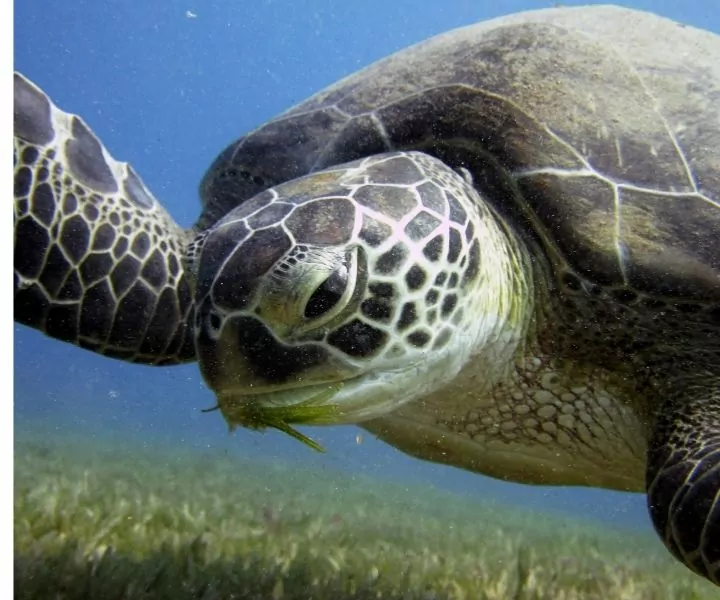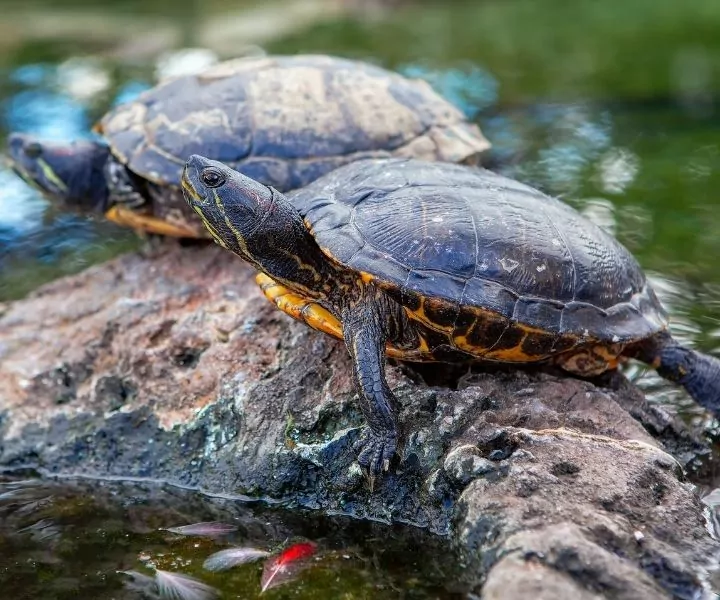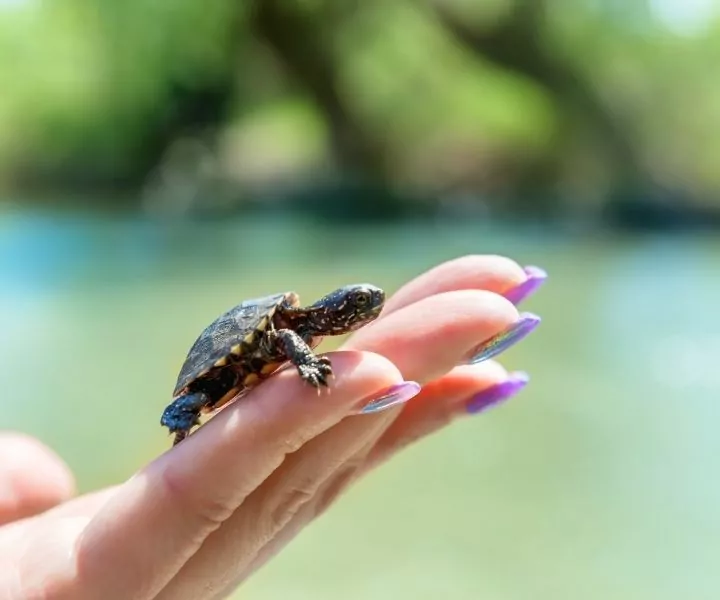Have you ever asked yourself these questions, “what do turtles eat?” “how do they find their food?”. “How many times do they eat?” “and do they really eat pizza?” Or is that just a myth?

Two of the most common questions asked when it comes to keeping turtles is the food they eat and how often they should be fed—knowing what to feed them and what it takes when it comes to maintaining a turtle.
So are you planning on keeping a turtle or enquiring for a friend? Either way, let’s find out together.
Do Different Types of Turtles Have a Different Diet?
The type of food one eats can be influenced by so many factors – availability of food, kind of food, safety in looking for food, type of mouthpart/jaw (anatomical/species differences), location of the animal, etc.
With this, you can easily deduce that each turtle has its own preferred diet. Bingo, you are correct! Even though some food diets may overlap between some groups, most turtle groups have their food preference.
Some turtles are herbivores (vegetarian and plant eaters), some are carnivores (meat-eaters), and some fall in the middle. They are omnivores (eat both plant and meat). Knowing the type of turtle you have and what they eat is the key to ensuring that your turtle lives a long and happy life with you.
The Different Types of Turtles And What They Eat
There are eight broad categories of turtles in the world, and as said earlier, each group has its preferred diet. So put on your guessing cap and see how many you can guess right. Spoiler alert, most turtles are omnivores!
Freshwater Turtles
This group of turtles eats almost everything. Worms, algae, lobsters, shrimps, crabs, barnacles, various water plants, water insects, snails, and insect larvae. They may and can eat fruits that fall in the water. Frogs, fish, snakes, small mammals, and sometimes even smaller turtles have been the diet of some species of turtles within this group.
Terrestrial Turtles
Terrestrial turtles have a vast range of food to choose from. Being on land gives them access to soil-burrowing animals, plants, as well as some terrestrial animals. Their diet includes grubs and snails, berries, flowers, beetles, mushrooms, caterpillars, grasses, and fruits. Some can also feed on decaying flesh when it is available.
Pet Turtles
Pet turtles (depending on the type you have at home) can be either omnivorous, herbivorous, or carnivorous. This would influence the kind of diet that would be fed, although most pet turtles are omnivorous.
Omnivorous pet turtles are fed or can be provided with a wide variety of diets. This can include but is not limited to fruits, commercial turtle pellets, vegetables, insects, and feeder fish. There are some herbivorous pet turtles as well. These are mainly fed fruits and vegetables. Carnivorous pet turtles are not usually common.
Baby Turtles
Baby turtles need the right amount of nutrients to grow properly. Healthy growth usually depends on the amount of protein in the diet as protein builds up body tissues. Therefore, baby turtles need a protein-rich diet. That means more fish and pellets than fruits and vegetables.
Water Turtles
Water turtles are a very picky set of turtles. They do not like to eat the same food over and over again. This shouldn’t be a problem because water turtles are omnivores. Thus they can eat a wide range of foods, which can be rotated often.
Water turtles feed on small fishes, romaine lettuce, bloodworms, red leaf lettuce, shrimps, endive, mealworms, endives and escaroles, kale, black worms, crayfish, krill, earthworms, and green leaf lettuce. They also eat commercial pellets too.
Land Turtles
Land turtles eat a wide variety of food ranging from plants to animals. Plant diets include; kale, pea pods, mango, beetroots, grapes, dandelions, tomatoes, peaches, kiwi, broccoli, papaya, romaine lettuce, banana, strawberries, and shredded carrots.
Animal diets include; caterpillars, earthworms, grasshoppers, snails and slugs, red worms, beetles, crickets, and wax worms.
Pond Turtles
Pond turtles should not be hand-fed directly, but food should be placed in a pond. Pond turtles being omnivores have their diets range from commercial pellets to a wide variety of fresh foods. Always try to have some aquatic plants planted in the pond for them to nibble on occasionally.
Pond turtle’s diets include collards, silkworms, slugs, dandelion, bloodworms, crabs, mealworms, krill, mustard greens, crickets, tadpoles, aquatic snails, waxworms, fish, bok choy, frogs, and earthworms.
Even though pond turtles are omnivores, remember that they are carnivorous when they are young and herbivorous when they grow old.

Sea Turtles
Sea turtles are omnivores with a vast range of diets. Amongst the sea turtles, some species feed on just plant-based food, others are strictly meat-eaters, and others do both diets – a little from each place. They eat algae, suids, seagrasses, shrimps, sponges, crabs, jellyfish, sea cucumber, and cuttlefish.
Do Turtles Eat Fish?
Yes, turtles eat fish. From both wild turtles to pet turtles, they all enjoy a fish meal. Fish provide turtles with the protein and vitamins that they need to grow, especially baby turtles. Fish such as goldfish and minnows are usually the common type of fish given to turtles.
Usually, those kept as pets are given fish pellets instead of raw fish. Others, depending on the availability, are given small fish to eat. Depending on the age of your turtle, they may or may not reject fish meal. Older turtles often tend to switch from fish-based diets to plant-based diets. This change in diet is due to and occurs with old age.
How Often Should Turtles Eat?
How often a turtle eats depends on its age – the older you get, the less amount of food you eat. Baby turtles should be fed every day since they require all the nutrients to grow. Adult turtles (i.e., turtles above seven years) should be fed every other day. This means, when you feed today, skip tomorrow but feed the day after that again.

Deciding on what portions to give to your turtle usually depends on how well your turtle eats. Some are slow eaters, and others are fast eaters. The size of the portion also depends on the weight of the turtle and its age. It is recommended to give one portion of food per day. This can be adjusted based on the above requirements.
Which Fresh Foods Can You Feed Turtles?
Turtles should be fed fresh food from time to time, and it should be a constituent of their diet. Plant-based fresh food that you can provide your turtles are:
- Kale
- Seedless melons
- Carrots
- Collard
- Peaches
- parsley
- Grapes
- Broccoli
- Duckweed
- Dandelion
- Banana
- Endive and escarole
- Tomatoes
- Bell peppers
- Romaine lettuce
- Apricots
- Elodea
- Strawberries
- Kiwi
- Green and red leaf lettuce
- Mixed berries
Animal-based fresh food you can feed your turtles are:
- Minnows
- Krills
- Crickets
- Earthworm
- Slugs
- Fish
- Mealworm
- Snails
- Wax worm
- Beetles
- Caterpillars
- Red worm
- Blackworms
- Shrimp
- Dubia roaches
- Locust
- Crayfish
- Superworms
Our Top Pet Turtle Feed Tips
Here are some tips to take note of when feeding your turtle.
- You can occasionally feed your turtle with meat from your table, such as chicken and beef, but it is not advised because meat does not contain the right amount of proteins turtles need compared to that found in fish. Never feed raw meat.
- Do not feed your turtle dog or cat food. Those foods contain a higher amount of protein than your turtle needs, which can cause great harm.
- It is appropriate and advised to feed your turtle in a different aquarium or habitat when feeding your pet. This is because turtles defecate when eating and can soil their primary habitat. Also, food in their main habitat would decrease the water quality, making it unfit for their health.
- When buying commercial food, brands are not usually significant. As long as they contain what you are looking for in the right proportions, you are good to go.
- When buying commercial food, look out for food that contains about 40-45% of protein and 6-8% of fat. Also, fishmeal should be listed as part of the top three ingredients. You should also make sure that the vitamins and minerals are listed on the label.
- When you are not sure of the type of food to give, always consult your veterinarian.
- Make sure the diet you are giving to your turtle is suitable for it. Feed herbivores, herbivorous diets; carnivores carnivorous diet; and omnivores, omnivorous diets. Never compromise.
- Occasionally add vitamin and mineral supplements to your pet’s diet.
- The best feeding times are usually mornings and early afternoons. This is recommended because this is the time they are most active and warm. (remember, they are cold-blooded).
- Also, spice things up by giving your turtle a varied diet to prevent it from growing tired of the food.
- Remember that every turtle has its preference, so be understandable if one turtle doesn’t fancy what the other likes.
The Ideal Habitat For A Pet Turtle
The ideal habitat for a pet turtle depends on the type of turtle, just like the type of diet they eat.
The habitat should be large and enclosed and should have almost the same conditions as its natural habitat. The enclosed space should be relatively high so that your turtle doesn’t climb out of it. An ideal habitat should have sunny and shady areas so your pet turtle can appropriately regulate its body temperature.
If it is in an aquatic turtle, the bottom of the enclosure should be filled with mulch or sand, and this must be changed regularly. Whether outdoor aquarium/pool or indoor aquarium, the habitat should also be large enough to facilitate swimming and diving.
If the enclosure is outdoors, provide shady and sunny areas for body temperature regulation. Also, aquatic turtles need a bit of dry land around their enclosure. This is to give them room from climbing out of the water when they desire.
Temperature Requirements For Indoor Turtles
Indoor land turtles require a basic amount of varied temperatures to help with body temperature regulation. Indoor turtles’ enclosure needs to be maintained at a temperature of 70-90°F (21-32°C). To provide the warm area to bask in, an additional area needs to be created with a temperature of 85-90°F (29-32°C).
Indoor aquatic turtles require a much higher temperature than land turtles. Their enclosure temperature should be between 75-82°F (24-28°C). The area for basking is also higher than those of land turtles. The temperature should be between 90-95°F (32-35°C).
Always remember to keep these temperatures constant by regularly checking using a room thermometer.
How Long do Pet Turtles Live?
Turtles are usually considered pets for life. This is because they live longer than the average pet (dogs, cats, rabbits, etc.). Therefore, turtles are a lasting commitment and investment.
Land turtles can live between 30 and 60 years, while aquatic turtles can live between 20 and 30 years.
These ages are not cut in stone and depend on so many factors such as overall health, feeding, nutrition, and accidents.
Are Turtles Low Maintenance Pets?
Low-maintenance pets are pets that do not demand excessive caretaking but do deserve love and general care. This is what allowed many turtles to be kept as pets. As long as they have a clean place to live and the correct diet, they are amazing pets to keep.
But it has been proven not to be all that true, that they are low-maintenance pets. They require a lot of care rather than just providing them with a place to sleep and food to eat. Their environment needs to be kept constant at all times, and because they naturally carry the bacteria salmonella, a lot of continuous effort to wash your hands with antibacterial soap after handling them is required.
Remember that nutrition is just a half of the actual work when it comes to keeping a pet and whether turtles are low maintenance pets are not, they require all the love and care they need, including vet checks.
And obviously, they don’t eat pizza in real life!
